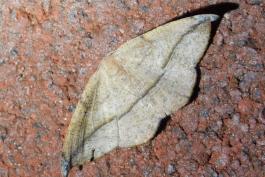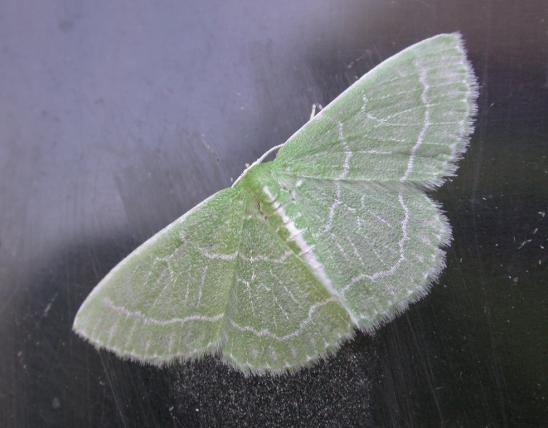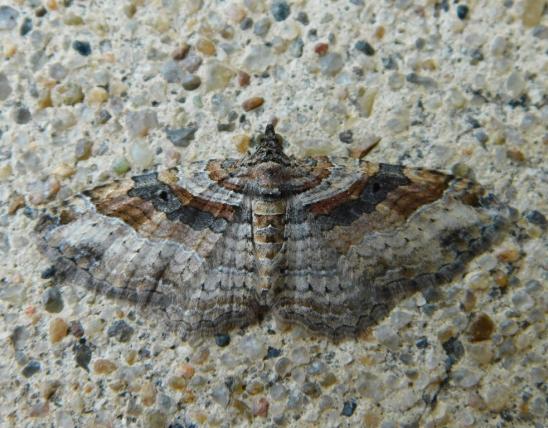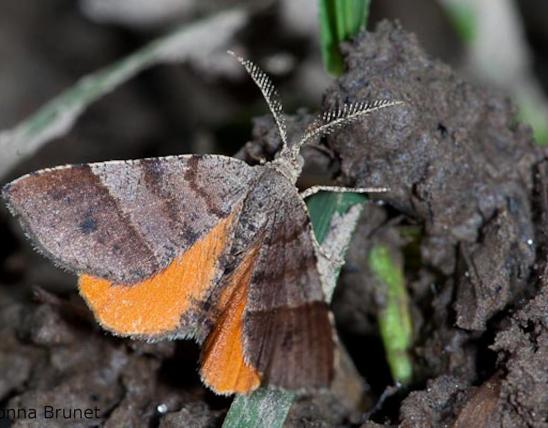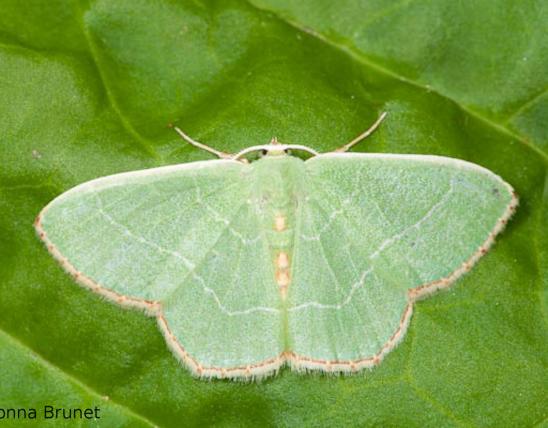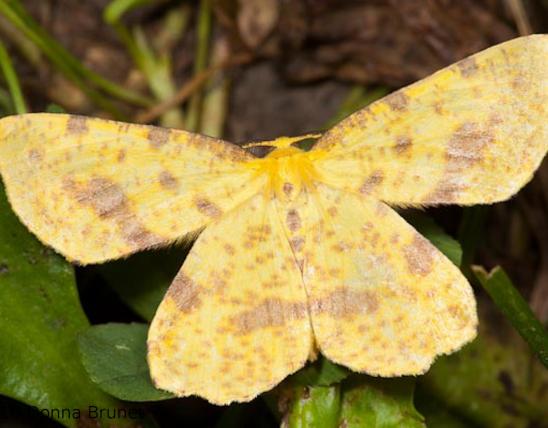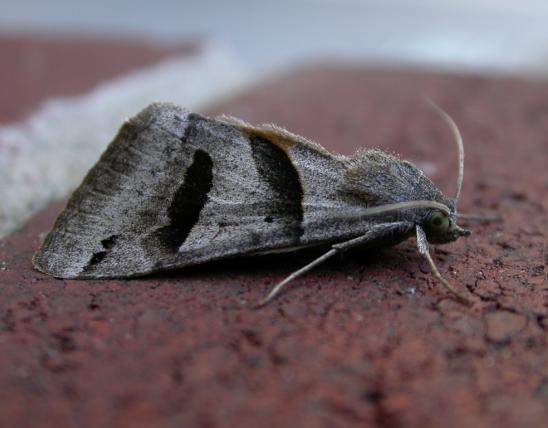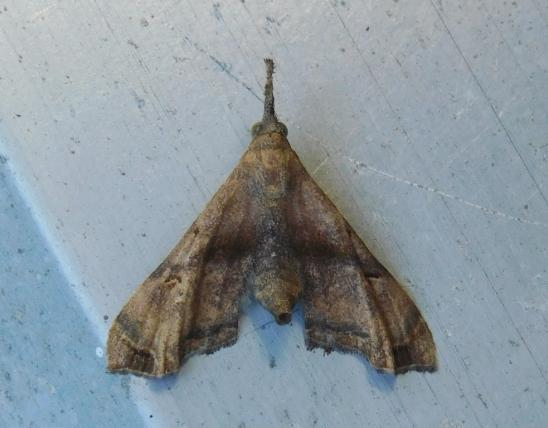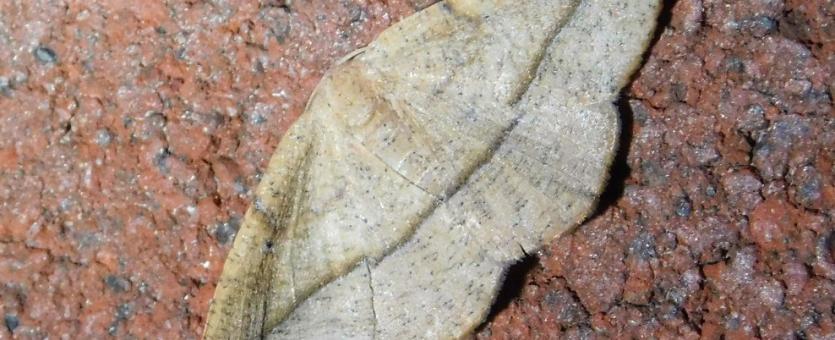
The juniper-twig geometer is one of many geometrid moths that look like a dried-up leaf. The overall tan color can be tinted orangish, pinkish, or rusty or reddish brown.
Like many other members of the geometrid family, they have rather thin bodies (considering they're moths), and they usually hold their wide wings spread flat out to the sides. The patterns on the forewings and hindwings are matched so that when the moth is resting, the lines appear continuous across all four wings. In this species, there is a conspicuous, usually dark postmedial line (a band running just beyond the midline of the wing). Where this line meets the leading edge of the forewing, it bends backward toward the wing tip. Where this line runs across the hindwing, it is straight (not wavy). The tip of the forewings is hooked, most sharply in females. The outer margin of the hindwing is smoothly rounded (not scalloped, wavy, angular, or pointed). In some individuals, there is a pair of large dark spots near the outer edge of the forewing.
The caterpillars are inchworms that mimic twigs. They are brown or gray with a series of slanted dark lines along the back and sides; this creates a series of alternating brown and gray diamond shapes, mimicking the pattern and texture of a cedar twig. At rest, like many other geometrid caterpillars, they tend to grip their perch with their hind legs and hold their bodies straight and stiff, at an angle to the twig.
To learn more about geometrid moths, see their group page.
Similar species: Several other geometrid moths are similar. Close attention to the above description should help distinguish between the juniper-twig geometer and its common lookalikes, which include the confused eusarca (Eusarca confusaria), the curve-toothed geometer (Eutrapela clemataria), the large maple spanworm (Prochoerodes lineola), the rose hooktip (Oreta rosea), and various moths in genus Osydia, Synaxis, and Tetracis.
Wingspan: ¾–1 inch.
Statewide. Common in the eastern United States.
Habitat and Conservation
Like other insects that are bound to specific types of larval food plants, this species will be most abundant in places where the food plants are abundant. The caterpillars grow up and pupate on and near cedars, and the females will be found near cedars, too, since they must deposit their eggs on the host plant. Males will be found in places where they will find females.
Eastern red cedars often form groves and thickets in places where disturbed land is reverting back to forest, such as in abandoned lots, in old fields and pastures, and along woodland borders.
Food
Like many other moths, this species is named for its principal caterpillar food plant: junipers. In our state, eastern red cedar (Juniperus virginiana) is the primary food. The caterpillars are amazingly well camouflaged when resting on juniper twigs.
Other food plants may include pines and nonnative, cultivated junipers and cedars, but in Missouri, with eastern red cedar so abundant, this moth has plenty of its favorite native food plant available.
Status
Resident moth with two or three broods per year.
Life Cycle
This species apparently overwinters in the egg stage. There may be two or three generations per year, and adults may be seen between April and the first hard frosts of autumn.
Human Connections
Insects are closely connected to the fortunes of their food plants, and in Missouri, the distribution and abundance of eastern red cedar has been profoundly affected by people. Ecologists have pointed out that, before European settlement, eastern red cedar was rather scarce in what is now called Missouri. Before Europeans arrived in our state, fires swept through many of our natural communities fairly regularly. The fires maintained Missouri's many large tracts of native natural habitats, including open woodlands, savannas, glades, and prairies. Cedars occurred in none of these habitats; they couldn't get established because the fires prevented them from attaining a size large enough to reproduce. About the only places where eastern red cedars occurred in our state were cliffs, surrounded by rock, where fire couldn't reach them.
When European Americans arrived in the Midwest, they suppressed fires, and the landscape changed. So-called cedar groves became common in places that once were sunny, open glades. Cedars now occur nearly everywhere in the state and are a sign of a disturbed, grassy habitat that is turning into a woods. Eastern red cedar has even been termed invasive, when it occurs in a native habitat where it doesn't naturally belong, such as a glade or prairie.
So, reflecting on the history of red cedars in Missouri, we have to wonder if the juniper-twig geometer hasn't also increased its numbers drastically since Europeans arrived.
We can ask the same question about the olive hairstreak (or juniper hairstreak, Callophrys gryneus gryneus), a small butterfly that also uses eastern red cedar as its caterpillar host. It is Missouri's only green butterfly. Before fire suppression, was it, too, rather scarce, gradually increasing its numbers as its host plant increased?
Ecosystem Connections
Their amazing camouflage is an adaptation that helps these moths to survive both in the caterpillar and adult stages. It is a sign that they are desirable to predators. A variety of animals seek these moths: at night, bats hunt them on the wing; during the day, birds look for them. Spiders hope to capture them in their webs, and a variety of other predators will eat them, too. The twiglike caterpillars are sought by any number of birds that hop and creep around in cedar branches — warblers, titmice, vireos, grackles, catbirds, and more.
Ecologists point out the tremendous cumulative importance of the many thousands of insects that are eaten by birds, especially during nesting season when birds need large amounts of protein. Many insects have particular native food plants they are tied to, so if we want birds to survive, we also must care for insects and their food plants.

